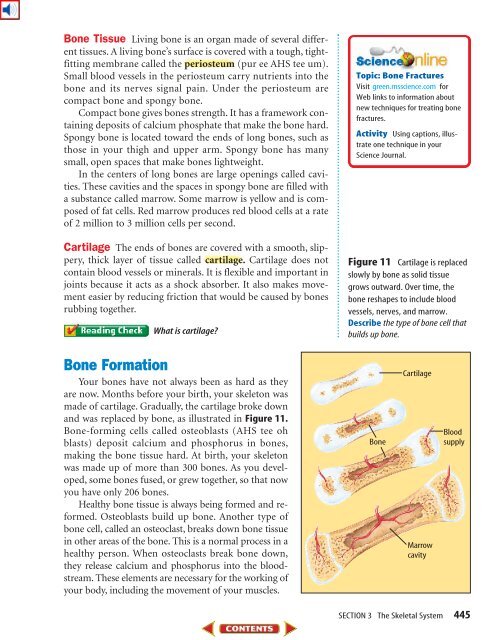Chapter 15: Support, Movement, and Responses - Science
Chapter 15: Support, Movement, and Responses - Science
Chapter 15: Support, Movement, and Responses - Science
You also want an ePaper? Increase the reach of your titles
YUMPU automatically turns print PDFs into web optimized ePapers that Google loves.
Bone Tissue Living bone is an organ made of several different<br />
tissues. A living bone’s surface is covered with a tough, tightfitting<br />
membrane called the periosteum (pur ee AHS tee um).<br />
Small blood vessels in the periosteum carry nutrients into the<br />
bone <strong>and</strong> its nerves signal pain. Under the periosteum are<br />
compact bone <strong>and</strong> spongy bone.<br />
Compact bone gives bones strength. It has a framework containing<br />
deposits of calcium phosphate that make the bone hard.<br />
Spongy bone is located toward the ends of long bones, such as<br />
those in your thigh <strong>and</strong> upper arm. Spongy bone has many<br />
small, open spaces that make bones lightweight.<br />
In the centers of long bones are large openings called cavities.<br />
These cavities <strong>and</strong> the spaces in spongy bone are filled with<br />
a substance called marrow. Some marrow is yellow <strong>and</strong> is composed<br />
of fat cells. Red marrow produces red blood cells at a rate<br />
of 2 million to 3 million cells per second.<br />
Cartilage The ends of bones are covered with a smooth, slippery,<br />
thick layer of tissue called cartilage. Cartilage does not<br />
contain blood vessels or minerals. It is flexible <strong>and</strong> important in<br />
joints because it acts as a shock absorber. It also makes movement<br />
easier by reducing friction that would be caused by bones<br />
rubbing together.<br />
What is cartilage?<br />
Bone Formation<br />
Your bones have not always been as hard as they<br />
are now. Months before your birth, your skeleton was<br />
made of cartilage. Gradually, the cartilage broke down<br />
<strong>and</strong> was replaced by bone, as illustrated in Figure 11.<br />
Bone-forming cells called osteoblasts (AHS tee oh<br />
blasts) deposit calcium <strong>and</strong> phosphorus in bones,<br />
making the bone tissue hard. At birth, your skeleton<br />
was made up of more than 300 bones. As you developed,<br />
some bones fused, or grew together, so that now<br />
you have only 206 bones.<br />
Healthy bone tissue is always being formed <strong>and</strong> reformed.<br />
Osteoblasts build up bone. Another type of<br />
bone cell, called an osteoclast, breaks down bone tissue<br />
in other areas of the bone. This is a normal process in a<br />
healthy person. When osteoclasts break bone down,<br />
they release calcium <strong>and</strong> phosphorus into the bloodstream.<br />
These elements are necessary for the working of<br />
your body, including the movement of your muscles.<br />
Topic: Bone Fractures<br />
Visit green.msscience.com for<br />
Web links to information about<br />
new techniques for treating bone<br />
fractures.<br />
Activity Using captions, illustrate<br />
one technique in your<br />
<strong>Science</strong> Journal.<br />
Figure 11 Cartilage is replaced<br />
slowly by bone as solid tissue<br />
grows outward. Over time, the<br />
bone reshapes to include blood<br />
vessels, nerves, <strong>and</strong> marrow.<br />
Describe the type of bone cell that<br />
builds up bone.<br />
Bone<br />
Cartilage<br />
Marrow<br />
cavity<br />
Blood<br />
supply<br />
SECTION 3 The Skeletal System 445
















